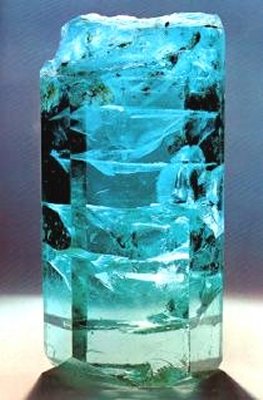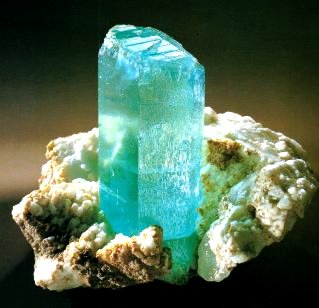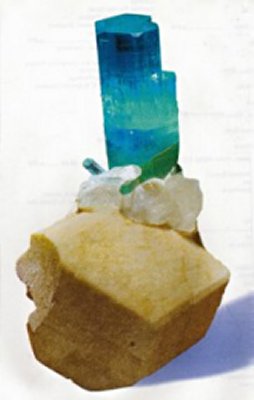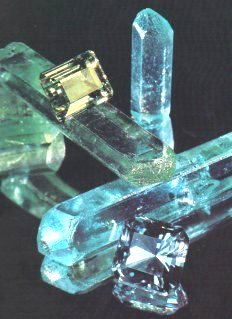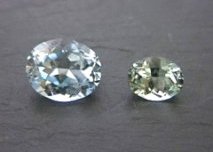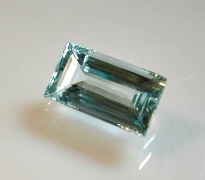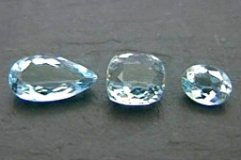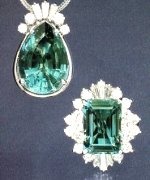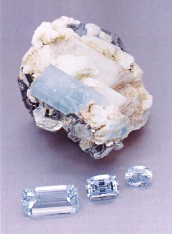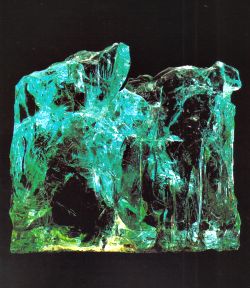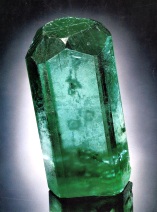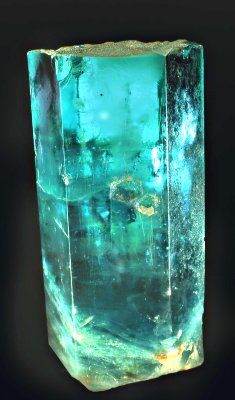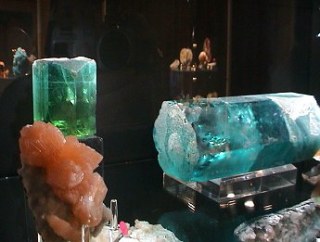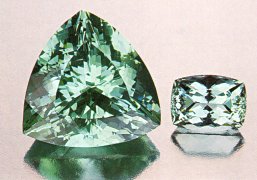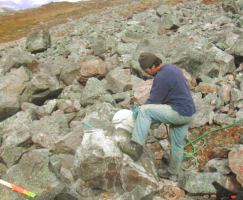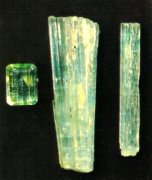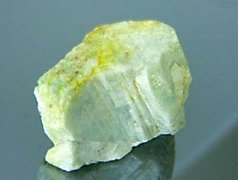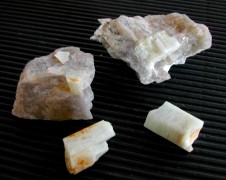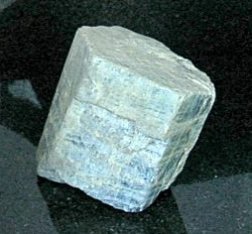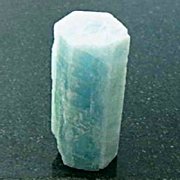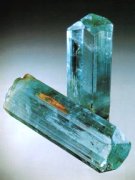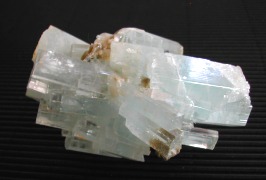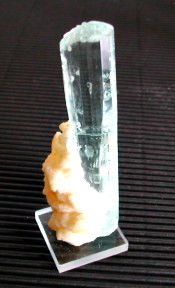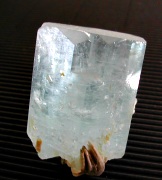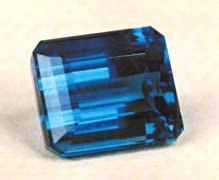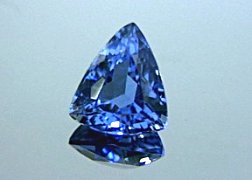アクアマリンは5000年もの昔からエジプト人によって知られていたようですが、その名は,ラテン語の”水=Aqua” ”海=Mare”が語源です。
アクアマリンとはその名のとおり、淡青色の透明な宝石質の緑柱石の呼び名でしたが、現在では宝石質ではない不透明な緑柱石結晶もアクアマリンと呼ばれています。
鉱物名は、18世紀のフランスの鉱物学者アウイの発案によるギリシア語の命名が一般的ですが、その他,産地に因む名前、鉱物学に貢献した学者名に因む命名等があります。宝石の名前は本来の鉱物名の他に様々な呼び名が存在します。
Aquamarine
has been known by ancient Egyptian for 5000 years. The name derives
from Latin "Aqua : Water and Mare : Sea".
Essentially, aquamarine
is a name for gemmy transparent blue beryl. But the name became
popular and today, even blue colored specimen crystal is generally
called aquamarine.
アクアマリンの色について
(Color of
Aquamaine)
”海の色”と名付けられたアクアマリンですが、一般に知られる淡青色のみではなく、産地により淡青緑色,淡緑色、時には深い青、と多様な色合いがあります。
これらの発色はいずれも主に不純物として含まれる鉄イオンのエネルギー状態の違いで光の吸収帯域が異なるために起こります。
一般に三価の鉄イオンでは黄色〜緑色に、二価の鉄イオンでは青となりますが、その他に二価と三価の鉄イオンとが酸素イオンを介して電荷をやり取りする電荷移動によって濃い青の発色が起こる例もあります。
世界各地のアクアマリンが多様な色合いを見せるのは、不純物のニ価と三価の鉄イオンの濃度が異なった割合で含まれていて、上記の様々な発色の組み合わせが起こっているためです。
昔から最も美しいアクアマリンを産してきたブラジルのアクアマリンには緑がかった結晶の産出が多く、天然のままでも充分美しい石も多いのです。
けれども一般に純粋な青い色のアクアマリンが好まれるため、グリーン・ベリル、ヘリオドールやモルガナイトも含む大半のベリルが加熱処理によって淡青から青のアクアマリンに変身します。
ただし、加熱処理をしても色が濃くなるわけではありません。 色の濃さは不純物として含まれる鉄の含有量が決定します。
Aquamarine color varies from pale blue to pale greenish-blue, pale
green and intense blue, depending on localities.
These different
colors are mainly caused by iron impurity : Pale blue is caused by
di-valent ferric ion impurity, green by tri-valent ferric ion.
However, charge transfer and inter-valence charge transfer with
between Fe2+ and Fe3+ through oxgen ion
contibutes darker blue, too. These complicated coloring mechanisms
give different rich hue to world's aquamarines.
The most important Brazilian quamarines are
generally green colored . But most of them are heat treated to becom
blue aquamarine to meet the market demands, as well as green beryl,
golden heliodor and pink morganite. Heat treatment changes only
colors and not color deepness, which is determined by the iron
impurity level.
一方、パキスタン、アフガニスタン、インドやナイジェリア、ザンビア、モザンビーク、マダガスカル等、他の地域産のアクアマリンには初めから青いアクアマリンが殆どで、加熱処理の必要が無いと言われます。
実際にアクアマリンが非加熱か否かを識別する事は不可能ではありませんが、一旦加熱処理された色は安定していますから、加熱処理により価値が問題とされることはありません。
Aquamarines
from other localities, such as : Pakistan, Afghanistan, India,
Srilanka, Nigeria, Mozambique and Madagascar etc., most of
aquamarines are intrinsically intense blue color and does not
require heat treatment. It is not impossible to identify if
aquamarine is heat treated or not. However, in general heat
treatment does not affect the commercial value, because of
popularity and color stability after heat treatment.
世界のアクアマリン (World's
aquamarine)
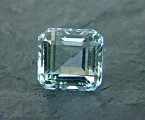 |
 |
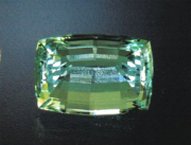 |
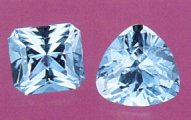 |
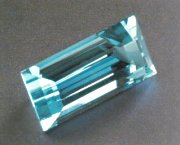 |
6.7ct 10.7x10mm
Minas Gerais
Brazil |
41.76ct
Kangyam,
Madras
India |
23ct
Klein
Spitzkoppe
Namibia |
3.14ct 3.53ct
Erongo Mtn.
Namibia |
21ct
Finarantsoa
Madagascar |
|
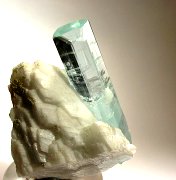
|
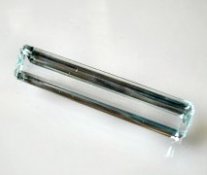 |
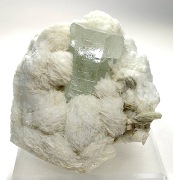 |
 |
 |
|
アクアマリンと曹長石
5.4x3.6x3cm
Shigar Valley
Pakistan
|
12.8ct
35.5x8.5mm
Pakistan
|
アクアマリン結晶 2.6ct 10x6mm
7.9x1.3x1.3mm
5.3x4.8x4.8cm
Fano mine, Coahuila Mtn. Riverside Co.
California
|
アクアマリンはスリランカ,パキスタン,アフガニスタン、インド、ナイジェリア、タンザニア,モザンビーク、ナミビア,マダガスカル等、世界の数多くのペグマタイト鉱山から安定した生産があります。
しかし、昔からブラジルが最も美しいアクアマリンの産地として知られてきました。
冒頭の写真の様に、世界の博物館に展示してある巨大で美しい結晶は大半がブラジル産です。
加えて、1980年代頃からパキスタンのカラコルム山脈の Dasso や Shigar 渓谷からアフガニスタンのヒンズークシュ山脈の
Nooristan に至るペグマタイト鉱脈地帯に美しい結晶が発見されるようになりました。
パキスタンやアフガニスタン産アクアマリンは一般に色が淡いため、宝飾用途より、むしろ結晶標本として高い人気があります。
時に色が美しい結晶を産しますが、それらもカットするよりは結晶として遥かに高く売れるため、博物館や富豪のコレクターが入手することになります。
つい最近ですが、ヴェトナムからもアクアマリンが報告されるようになりました。 しかし数量は限られています。
アメリカ合衆国は東部にメイン州、西海岸にサンディエゴと代表的なペグマタイト地帯があり、トルマリン,スペッサータイン・ガーネットモルガナイト、クンツァイト等の宝石では世界有数の産地です。
ところがアクアマリンに限っては何故か宝石質の結晶は殆ど産出しません。
僅かにコロラド州のアンテロ山とカリフォルニア州、サンディエゴのペグマタイト鉱床から時々美しい宝石質の結晶が採れます。 殆どがコレクター向けの結晶標本となります。
Aquamarine is produced worldwide from Srilanka, India, Pakistan,
Afghanistan, Nigeria, Tanzania, Mozambique,Namibia,Madagascar,
etc. But Brazil has been the most important and dominant producer of
gem aquamarine, since long.
We see superb crystal collections at
museums and most of the striking aquamarine crystals are of
Brazilian origine. Since 1980's, beautiful aquamarinecrystals from
Pakistan and Afghanistan appeared to the world market. They are both
from pegmatite of Dasso and Shigar Velley of Karakoram Mtns,
Pakistan and Nooristan Velley of Hindukush, Afghanistan. Although
beautifully shaped, because of pale color, most of Pakistan and
Afghan aquamarine crystals are sold as crystal specimens rather than
jewellery use.
Recently, aquamarine from Vietnam appeared into
the world market but with limited quantity.
United States has
many gem producing pegmatite zone, such as California and Maine etc.
Tourmalines, spodumen, spessartine, morganite etc. are the
representative gems from these locality.
However, it is strange
that agem quality aquamarines are rarely reported and very few
crystals are seen as specimen.
ロシアのアクアマリン (Russian Aquamarine)
 |
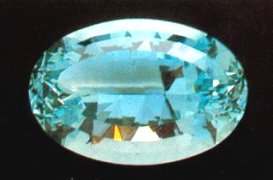 |
 |
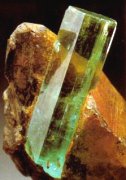 |
|
1091ct
88.6x49.8x34.9mm
|
674ct
73.5x50.0x34.5mm
|
left 5.1cm
Alabaschka, Ural Mtns.
Russia
|
ロシアはかつてウラル山脈やシベリアで素晴らしいアクアマリンを産しました。
今日ではロシア産のアクアマリンを市場で見かけることはまずありません。
が、写真の透明な結晶標本からも、その品質の素晴らしさがうかがえます。
同じく巨大なルースの写真はロマノフ王家のコレクションであったと言われるものです。
1995年にロンドンでクリスティーズのオークションに出品されました。
これほど大きく質の良いアクアマリン・ルースが世に出るのは50年来の事と話題になったものです。
落札価格はペアで11〜16万ドルと予想されましたが、さて誰がいくらで落札したのかは定かではありません。
現在は何処に ?
Once,
Russian aquamarine from Ural Mtns. and Siberian pegmatite have been
the legendary gems. Today, we seldom have an occasion to see
Russian aquamarine in the market. Did Russian pegmatite exhasuted ?
A few example of the transparent crystals remind us of its legendary
quality.
Phots of the huge facetted aquamarine are said to have
come from the collection of The Romanof Family. They were presented
at the Christy's auction at London in 1995 to appeal that such huge
and high quality aquamarine was an event since 50 years.
The
contract price was estimated from US$110,000 to 160,000.
But it
was not reported who awarded at which price. Where are they now
?
ブラジルのアクアマリン
(Brazilian Aquamarine)
Renowned Brazilian Aquamarines
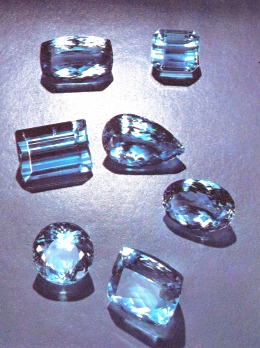 |
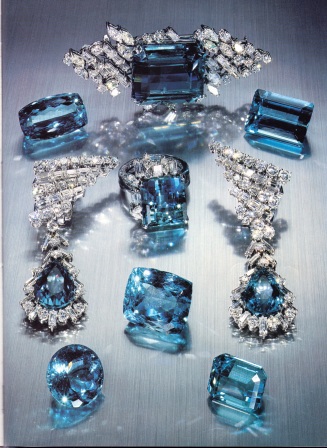
|
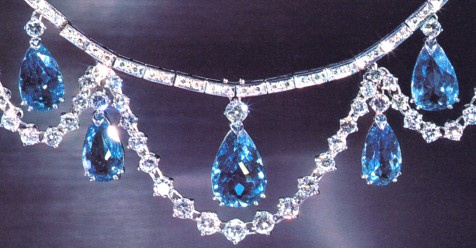 |
|
ムクリ川流域のアクアマリン
Mucuri river
aquamarine
18〜35ct
|
マルタ・ローチャ品質のアクアマリン
Martha Rocha quality aquamarine
ブローチ(brooch) 54ct
指輪(ring) 35ct Medina
mine
|
コロネル・ムルタ鉱山産アクアマリン
中央の石(center stone)
5ct
Coronel Muruta
mine
|
|
|
|
|
|
|
ブラジルのアクアマリン鉱床 (Brazilian aquamarin
deposits)
 |
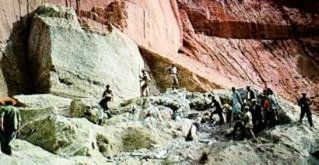 |
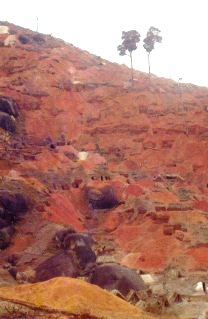 |
|
 |
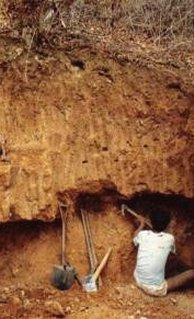 |
|
ミナス・ジェライス州北東部のペグマタイト
青印のイニシアルがアクアマリン産地 赤はトルマリン
Pegmatite
mines of North-Eastern Minas Gerais;
La:Laranjeiras F:Frade−Colonel
Murta Mx:Maxixe
FL:Fortaleza Me:Medina HI:Happy Island
Mu:Mucaia−Murundu Q:Quarto Centenario
P-TB-U:Pioneer−Três Barras−Urubu P:Papamel
Ub:Mina Urubu MR:Marta
Rocha |
上(top) : Padre Paraisoの初成鉱床
(Primary Pegmatite Dike of
Padre Paraiso)
下(bottom) : Malambaia川流域の漂砂鉱床
(Alluvial deposit of Malambaia
River) |
上(top)
Três Barrasの残積鉱床
(Elluvial
Deposit)
下(bottom)
Frade Valleyの漂積鉱床
(Colluvial Deposit) |
|
ブラジル各地は昔から質、量ともに抜きん出たアクアマリンの産出国として知られています。
北東部のリオ・グランデ・ド・ノルテ州とパライバ州にも産しますが、何と言ってもミナス・ジェライス北東部からエスピリト・サント州とバイア州にまたがる地帯は、20世紀初頭以来素晴らしい結晶を産出し続けて来ました。
とりわけ、リオ・デ・ジャネイロの北東100km程のパライバ川周辺からほぼ真北に幅 300km、長さ 800km
に及ぶペグマタイト地帯には数千ヶ所のアクアマリン産地が存在します。
ブラジルではペグマタイトの鉱脈そのものを採掘する初成鉱床、周囲の岩脈が風化して結晶のみが集積している残積鉱床、さらに結晶が広く拡散して残っている漂積鉱床、それらが河川に押し流されて下流の川床などに堆積している沖積(漂砂)鉱床、と多様な産出状況で発見されます。
したがって、この広大な地帯の至るところにアクアマリンが発見されるのです。
Brazil has been renowned as an outstanding
aquamarine producer of the world. Aquamarine is mined in Rio Grande do Norte and
Paraiba states. However, the most significant mines are located from
north-eastern Minas Gerais to Espirito Santo and Bahia states.
Particularly, 100km north east from Rio de Janeiro, pegmatite zone
lying 300km wide and 800km north from Paraiba river area are the
major aquamarine producing zone with several thousands of
mines.
In Brazil, aquamarine
crystals are found in various conditions ; primary pegmatite
dike, where gem crystals are in place(in situ) in the
surrounding host rock and different secondary deposits ; elluvial
deposit where old vein weathered away and the altered decomposed
gem pocket settled in the gravels and clays, colluvial
deposit, where decomposed dispersed gem pockets moved both
vertically and laterally down-slope, alluvial deposit : Lies
in gravel on the valley floor and gem stones, in the ancient river
bed, are often rounded from having been tumbled.
Therefore,
aquamarine crystals are mined everywhere in these vast
areas.
数多い産地の中で、テオフィーロ・オトーニの北50kmにあるマランバイア渓谷とアラスアイの北西、フラージ渓谷のコロネル・ムルタ
- ラランジェイラス一帯とは、とりわけ歴史に残る大きく美しい見事なアクアマリンの結晶を数多く産出してきました。
今もニューヨークのアメリカ自然史博物館には、1910年にパパメル鉱山で発見された史上最大かつ、最も美しいと言われたアクアマリンの結晶の一部が展示されています。
写真でも分かると思いますが、素晴らしく透明度が高く、50cm近い結晶の下に置かれた新聞を上から覗き込んで読む事が出来たと言われています。
この結晶の価値は今日では2500万ドル(約30億円)と言われているそうです。
また、次のピオネア鉱山にて1967年に発見された ”暁の星 (Estrela de Alva)” と名付けられた結晶もほぼ100%近い宝石質の巨大な結晶でした。
ピオネア鉱山では当時このような結晶が1500kgも採れたとの事ですが、殆どが宝石用にカットされてしまい、僅かに下、右の結晶が残されているのみです。
Among
many localities, Marambai Valley, 50km north of Teofilo Otoni, and
Coronel Murta-Larangeiras area along Frade Valley, north west of
Araçuai have been produced historical crystals. As shown in the
following photos, a superb crystral displayed at The American museum
of Natural History, New York is a part of the biggest and the most
beautiful ever found in 1910 at Papamel mine. This crystal is so
clean that a newspaper located beneath the 50cm high crystal can be
read from the top.
The value of this crystal is estimated US$25
millions, today.
Next photol, mined in 1967 at Papamel mine and
named "Estrela de Alva" was huge(100cm and 19.6kg) and entirely
gemmy
crystal. Although Pioneer mine produced 1500kg of such
crystals, almost all were cut for gemstone and only one specimen is
reserved as keith Proctor collection.
